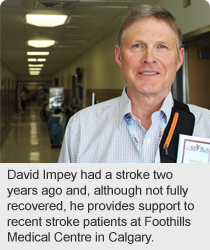
June 3, 2015
Story and photo by Colin Zak
For every stroke patient, there’s some telltale sign or symptom that they are having a stroke.
For David Impey, he was unable to speak.
“I was only able to get a few words out but I didn’t recognize what I was saying,” says the 61-year-old, who had a stroke in March 2013. “Fortunately, my wife recognized my symptoms and called the ambulance. I was in hospital within an hour.”
After several days in hospital, eight weeks of daily in-home rehabilitation and ongoing rehabilitation in the community, Impey’s speech has improved dramatically – although he still at times stumbles on his words and still struggles to read and write.
 Today, he makes weekly visits to the stroke unit at Foothills Medical Centre to offer counselling and support to patients who have recently had a stroke.
Today, he makes weekly visits to the stroke unit at Foothills Medical Centre to offer counselling and support to patients who have recently had a stroke.
During the month of June, which is Stroke Month, the Heart and Stroke Foundation and Alberta Health Services (AHS) are partnering to ensure Albertans know the signs of stroke and are equipped with a stroke checklist. Now, all you need to remember is FAST:
Face – is it drooping?
Arms – can you raise both?
Speech – is it slurred or jumbled?
Time – to call 9-1-1 right away
“Recognizing the signs and symptoms of stroke and knowing what to do are crucial to ensuring the best chances of survival and recovery from a stroke,” says Shelley Valaire, Senior Provincial Director of the Cardiovascular Health and Stroke Strategic Clinical Network (SCN) of AHS.
“We all have a part to play and it starts with knowing how to recognize the signs of stroke.”
A stroke is a sudden loss of brain function caused by a blockage of blood flow to the brain or the rupture of blood vessels in the brain. The interruption of blood flow to the brain causes brain cells – also known as neurons – in the affected area to die.
Each year, 62,000 strokes occur in Canada. That’s a stroke every nine minutes. However, only one-third of Canadians are able to describe what a stroke is and identify the symptoms of stroke.
“When it comes to strokes, we often say that time is brain. Recognizing the signs of stroke early and quickly getting that patient to hospital improves their chances of survival and recovery with little or no disability,” says Dr. Michael Hill, Director of AHS’ Calgary Stroke Program.
“The public, paramedics, emergency department staff and other medical professionals all play a vital role in early stroke management.”
Hill notes Emergency Medical Services (EMS) play a critical role in managing strokes, by gathering information about existing medical conditions and establishing when the stroke occurred.
In hospital, patients receive specialized stroke care, including the clot-busting therapy tPA when appropriate. However, less than 40 per cent of eligible patients arrive within the 4.5-hour treatment window for this therapy.
Patients experiencing severe strokes caused by larger clots may be eligible for endovascular treatment, which physically removes the clot using a tiny device inserted via the blood vessels. This treatment must take place within six hours for most patients.
“When it comes to stroke, early intervention is key,” Hill says. “Albertans need to do their part and ensure precious time is saved.”
Visit heartandstroke.com to learn about the signs of stroke and for other stroke-related resources, and consider printing the FAST signs of stroke checklist and displaying at home or in the office.